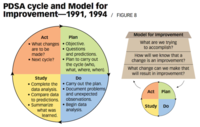Posts selected fromManagement Blog - Engineering Blog - Investing Blog and other blogs - Bill Hunter and the Quality Movement
 In the presentation George Box discusses interesting student design of experiments projects; read more on those efforts in 101 Ways to Design an Experiment, or Some Ideas About Teaching Design of Experiments.
...
George's closing statement:
We carry in our hearts the inspiring memory of not only a scholar but a man that was resourceful, warm, skillful, courageous, optimistic, helpful, enterprising and generous. His career was whole and balanced in a way that is rare and as we grieve his death we also celebrate the life of a remarkable man.
continue reading: Bill Hunter and the Quality Movement - Deming on Management: Psychology
 Within Deming’s SoPK the psychology component includes an appreciation of:
- how will people are influenced by management policies (for example, targets or a culture of blaming individuals)
- the innate desire people have to take pride in their work
- how people resist change (and how to reduce that resistance)
- confirmation bias (one way our brains can lead us astray)
- what drives people to behave as they do
- and much more - continue reading the rest of the post to learn more...
continue reading: Deming on Management: Psychology - Alley Spring Mill Trail, Missouri
 The Alley Spring Mill is in the Ozark National Scenic Riverway (part of the National Park system). The mill itself looks wonderful next to the pond and also has some interesting details inside.
Corn and wheat was loaded at the ground level of the building and moved up to the top via the tiny buckets driven by the water wheel. Then the grain was filtered and ground using the water wheel as the source of power (moving up via the mini bucket elevators and down shoots to the machines on the ground level in sequence)... continue reading: Alley Spring Mill Trail, Missouri - How to Successfully Lead Change Efforts
 In order to lead efforts to improve the management of an organization understanding how people will react to change is critical. For that reason I have written about change management often on this blog since I started publishing it in 2004.
In, Why Do People Fail to Adopt Better Management Methods?, I wrote:
It seems that if there were better ways to manage, people would adopt those methods. But this just isn’t the case; sometimes better methods will be adopted but often they won’t. People can be very attached to the way things have always been done. Or they can just be uncomfortable with the prospect of trying something new.
Leading change efforts requires paying attention to the existing conditions: the culture, the motivation to adopt this change and/or the motivation to resist it, the history of change where the change is being attempted and the reasons the change is desired (by at least you and hopefully others). And then you need to build a case for the change and manage the process. continue reading: How to Successfully Lead Change Efforts - Human Resources in the Post Deming Era
 - Deming on Management: PDSA Cycle
 - Factfulness – The Importance of Critical Thinking
 I have come to see a willingness to value critical thinking, even when it means forcing the organization to address tough issues, as one the differences between organizations that succeed in applying management improvement methods and those that fail. In many organizations that fail, more weight given to making things easy for your bosses versus continual improvement in providing value to customers (which often requires challenging existing processes, beliefs and power structures in the organization).
Challenging the status quo is difficult and most organizations prefer to maintain a culture that takes an easier path. Management improvement often requires a willingness to encourage challenges to the status quo. The importance of challenging the status quo in your organization and in your own thinking is under appreciated. continue reading: Factfulness – The Importance of Critical Thinking - Leading The Transformation Process
Transformation starts with the individual but as they change they can run into organizational barriers and resistance to change. Similarly if the organization institutes changes without helping people change their own understanding and views those people resist the changes in the organization.
Deming’s management system provides a view of the organization as a system, including the people in that organization, and ideas for how to manage the transformation as an integrated system. The interactions between the components of the system and people must be considered and managed to transform. And those interactions continually change as the overall system evolves.
continue reading: Leading The Transformation Process - Design the Management System with an Appreciation of Confirmation Bias
 To create strong organizations we must create management systems using an appreciation of psychology. We must understand that people have tendencies that must be addressed by designing a management system built to take advantage of the strengths those people bring and mitigate the risks of the weaknesses (such as confirmation bias) that those people also bring.
One way to do this is to seek out voices in your organization that question and challenge accepted positions... continue reading: Design the Management System with an Appreciation of Confirmation Bias - Shared Principles for Managing People Engaged in Diverse Tasks
 ...I do agree that the system within which people are operating determines how they must be managed. There are definitely features of software development that are significantly different than manufacturing scalpels or basketballs or tables. As there is a difference between a surgical team in an operating room, road construction, mining, editing books, investment banking, manufacturing industrial robots, researching new drugs, manufacturing drugs, teaching in a university, maintaining plane engines, coaching an athletic team...
I see universal principles of management (respect for people, customer focus, continual improvement...) that cross all different human enterprises. How those principles should be manifest in a particular situations depend on the work being done, the management system that is in place, the individual people involved, the specific focus of the effort right now... The way those principles are manifest will look very different in all the varied types of organizations we create and the different work and processes used within those organizations.
... continue reading: Shared Principles for Managing People Engaged in Diverse Tasks - Leading Quality: Some Practical Approaches to the Managers New Job
 Throughout the talk Peter emphasis the importance of viewing the organization as a system and using the knowledge from that view to inform how the organization is lead, managed and how people are able to work. With a systems view it is possible to appreciate how many individual factors interact to impact how successful an organization can be and how those factors interact with each other.
...
Peter Scholtes:
We need to define what our customers get from us, not in terms of the product that we sell or the service that we offer, but in terms of capability that they acquire from us.
continue reading: Leading Quality: Some Practical Approaches to the Managers New Job - My Willing Worker Award

Data very similar to that provided by the Red Bed Experiment is used everyday in businesses to reward and punish people. Data is used to blame those who fall short of expectations and reward those who have good numbers. In the Red Bead Experiment we know the numbers are not a sensible measure of value provided by the employee. But in our organizations we accept numbers that are just as unrelated to the value provided by the employe to rate and reward employees.
There is a powerful need to improve the numeracy (literacy with numbers) in our organizations. It isn’t a matter of complex math. The concepts are fairly simple…
continue reading: My Willing Worker Award - Privacy Invasion as a Business Plan
One of the worst behaviors by internet companies is to collect phone numbers in order to facilitate selling and integration of private information while pretending it is somehow a security issue. Though security experts all say using phone numbers for security adds security risks instead of using much more secure methods such as a security key. Companies that use deceptive security methods to collect phone numbers in order to sell the private information of their users make it very hard to trust what else they are doing.
Twitter has long claimed a security reason to collect phone numbers [Twitter faces $250 million fine from the US FCC for these practices abusing the private information of users]. continue reading: Privacy Invasion as a Business Plan - Rethinking Statistics for Quality Control with George Box
George Box shared a presentation on Rethinking Statistics for Quality Control at the 2008 Deming Institute Conference in Madison, Wisconsin.
In the presentation George discusses how to look at data from a process. He mentions why it was so important to understand what Shewhart understood about process data: the order of the data is extremely important; which is why run charts and control (process behavior) charts are plotted in time order... continue reading: Rethinking Statistics for Quality Control with George Box - An Inverted Yield Curve Predicts Recessions in the USA
 The chart shows the 10 year yield minus the 2 year yield. So when the value falls below 0 that means the 2 year yield is higher. Each time that happened, since 1988, a recession has followed (the grey shaded areas in the chart).
Do note that there were very small inversions in 1998 and 2006 that did not result in a recession in the near term. Also note that in every case the yield curve was no longer inverted by the time a recession actually started.
... continue reading: An Inverted Yield Curve Predicts Recessions in the USA
|